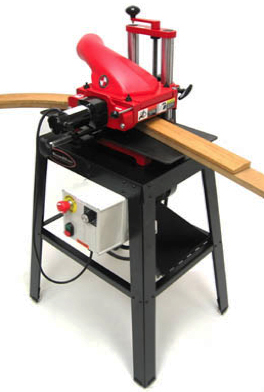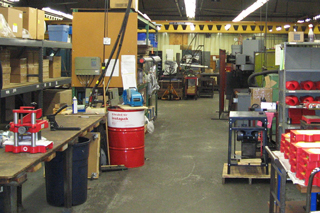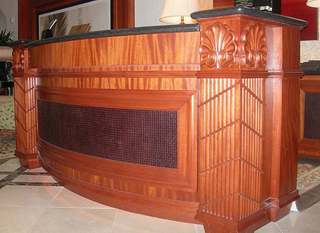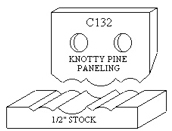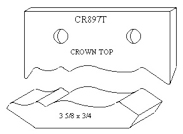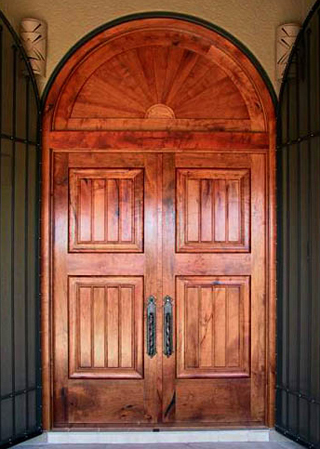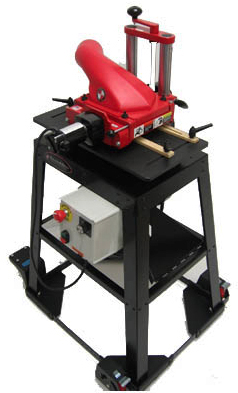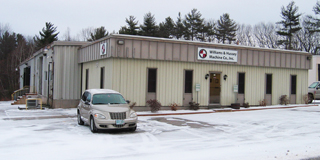
If you’ve ever walked down the millwork aisle of your local home center or lumberyard and been disappointed at the options, you might have wondered what it would take to get something more unique. Or made from some wood species other than red oak, poplar or pine. I know I have.
There are two options: you could order that special mahogany, walnut or cherry molding from a millwork company and pay the premium price. Or, you could mill it yourself…from any wood species that suits your fancy. Imagine that!
Stephen Carter, president of Williams & Hussey Machine Company (W&H), doesn’t have to dream about it. His company has been making portable molder machines in their 10,000-square-foot New Hampshire facility since the mid 1950s. For the folks at W&H, there’s nothing “run-of-the-mill” about building machinery that can cut nearly 200 different styles of standard moldings. That task is the order of the day. And the agenda really hasn’t changed much since day one.
Steve explains that, back in the mid-’50s, Thurston Williams and Forrest Hussey were innovators in their own right. At the time, there were no small, portable molder/planers available. So, the two men, who both had a background in metal cutting tools, put their heads together and designed the “W7 Handfeed” machine, a portable unit designed to plane boards up to seven inches wide. It didn’t take long for boatbuilders along the Atlantic coast to catch wind of it and start taking it to their jobsites. The success of that model led to two more machines: the W7PF, a unit with a power infeed roller, followed by the W7S “Super”, which had both power indeed and outfeed enhancements.
“In those days, Williams & Hussey machines were being sold at hardware stores. We didn’t have distributors, and the company didn’t advertise much. Then in 1976, the same year I came on board, Popular Mechanicspublished an unsolicited article about our molders. That was the Time Magazine of its era for our woodworking and home improvement industry. The phones started ringing off the hook with inquiries,” Steve says.
It was this exposure that put Williams & Hussey on the map, so to speak, to small millwork operations, carpenters and restoration specialists, among others. Custom millwork now became easier than ever to manufacture for the masses quickly and cost-effectively, wherever the end user needed to make it.
Still, despite ramping up production to supply machines for a growing customer base, the company held tenaciously to some fundamental values of doing business. Steve says the organization has always maintained complete quality control over manufacturing. All of the machining, painting, assembly and testing of the product line happens in-house. Williams & Hussey stocks parts for all models back to the original W7 line, and it still services everything they’ve manufactured to date, because many of the earliest models are still in operation in millwork shops today. Castings and other parts come from American suppliers. The cast-iron tables and housings, for instance, are made by a small, family-run foundry in Rhode Island.
“When you’ve been in business for as long as we have, you work through a lot of supplier and quality control issues…You know who makes the best parts to give you the level of quality you demand.”
Steve is particularly proud of the company’s “backwards compatibility” philosophy. “Whatever we come out with that’s new, we make sure it’s adaptable to all of our earlier models…Right to this day, you can convert even the earliest machines to bring them up-to-date with today’s model features, such as converting a constant-feed machine to variable feed speed.”
Currently, Williams & Hussey manufactures three different molders. Steve says the company’s Model 206, a 2HP, 220-volt unit, is most popular because of its variable feed-speed control. Williams & Hussey also manufactures the Model 154, a 2HP molder that has a constant feed speed. It’s considered to be the “workhorse” of the trio and sells for about $800 less than the 206. The newest machine in the model line-up is the Model 209, which, due to customer request, has a 1-1/2 HP motor wired for 115 volts. It offers a good tradeoff for those in smaller shops or who need jobsite power compatibility.
Steve pointed out some other key features of his machines. The knives are self-aligning on the cutter heads and simply bolt in place. “They take about two to three minutes to change over; four minutes if you drop the wrench,” he says. Simpler, safer controls and switches, an innovative dust collection hood and improved rolling bases are some other recent innovations. William & Hussey molders can cut constant-radius arches, a unique capability because of their open-ended design, and you can even mill elliptical shapes with changing radii using a special jig. The molders come with a seven-year warranty, which Steve feels testifies to their durability.
“We sell to lumberyards and shops that work these machines all day, every day. They absolutely must perform reliably, and we make sure they will, year after year.”
All three models will accept the company’s full line of molding knives, which number around 180 different in-stock patterns. They range from conventional base molding styles to flutings, beaded designs, quarter-rounds, crown and and raised panels. Knives cost between $50 to $150 per pair, and they are ground in the company’s in-house shop. W&H will also regrind dull knives for a $28 fee.
“We can make almost any custom profile as well, provided the molding is not wider than 6-3/4 in. or with a maximum depth-of-cut not exceeding 3/4 in.,” Steve says.
Steve admits that the company’s primary customer base isn’t home-shop woodworkers. W&H molders range in price between $1,995 and $2,795, which is outside the budget of many hobbyists. But, the company offers a discount program to high schools, trade schools, vocational institutions and colleges. The core clientele consists of cabinet and millwork shops, lumberyards, restoration specialists and the furniture-building industry. Even so, Steve says the discriminating hobbyist woodworker who appreciates high-quality machinery will not be disappointed investing in a molder.
Oh, and then there are a few notable end users we all probably know by name. Steve recounts that back in 2000, a certain Norm Abram called him and requested a Williams & Hussey machine for “The New Yankee Workshop.” Shortly thereafter, “This Old House’s” Tom Silva came calling as well. “I told Tom that he should give Norm a call, because I had just delivered a molder/planer to him a few weeks prior. Tom said he’d already tried that. Norm liked it so much that he wouldn’t let Tom borrow it. Not even for a day.”
There’s a testimonial that’s pretty hard to beat.
